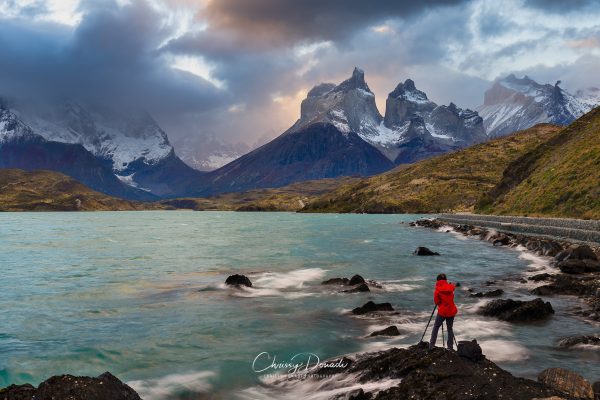As landscape photographers, perhaps we take more risks with our equipment than others. However, don’t tell my insurance company that. I don’t even bat an eyelash about jumping into a pair of fishing waders and walking out into a stream of moving water with thousands of dollars worth of camera equipment on the top of my tripod. For the number of times I have slipped on a slimy rock, you would think I would think twice. But landscape photographers just don’t. Having our camera one inch away from a body of saltwater in Iceland’s Glacier Lagoon or placing a tripod near the mountain ledge of the Swiss Alps as the wind whips at our face IS the dream. So maybe camera insurance is worth some research to keep that dream from becoming a nightmare?
Naturally, we do what we can to protect our precious camera gear (insert Gollum GIF here), but accidents happen. It is almost a rite of passage to have a story about how you damaged your first big piece of camera gear. Personally, my first big piece of gear destroyed was a camera body that took a dip in that salty Glacier Lagoon in Iceland. But hearing stories about how photographers have dropped a camera off a bridge, mountain, or drove away after leaving their camera on the roof of their car is a fairly common discussion topic when we’re relaxing around the campfire. Although, at what point in the journey from hobbyist to amateur to professional do you personally need camera insurance?

Camera Insurance Risk Assessment
First, what is the value of your more expensive camera equipment? Consider the cost of your camera body, lenses, tripod, and laptop if you have one. For this analysis, I would not recommend including lower-cost items, such as memory cards or batteries. Depending on how much you have invested in your filter system, photography filters can go into either bucket here. Chances are you can accept financial responsibility to replace them. Additionally, insuring the smaller items typically isn’t worth the cost of insuring them over time. Moreover, making small damage claims isn’t worth increases to your premium. In the long run, you’ll save more money by paying for the cost of minor repairs or less expensive items.
Second, what is the probability of theft or damage? Do you live in a high-crime area or area where natural disasters like floods, hurricanes, or wildfires are common? Do you primarily shoot a few times a year close to home or do you travel every month all over the globe? If traveling, do you consider the travel destinations to pose a great risk for theft? Similarly, do you often take your camera to locations that risk damage to your equipment? Are you a klutz? It’s a fair question here.
Third, how difficult would it be to replace all of those big-ticket items or even one of them? This is a personal inquiry. Can you replace a lost or damaged lens right away? If not, can you be without the lens or afford to rent a replacement until you are able to purchase a replacement? If you truly cannot afford to be without the camera gear or it will be near impossible to replace within a reasonable timeframe, then some type of camera insurance sounds like a reasonable expense.
What Does Camera Insurance Cover?
Photographer’s equipment insurance covers cameras, lenses, computers, lighting equipment, rented equipment, and any other electronics used. Additionally, it can cover any bags or packs as well as transporting materials. This insurance is broad and can cover you for damage/loss from theft, breakages, fire, vandalism, wind, water, etc.
Typically, this is set up for working professionals. Equipment insurance, also known as Business Property Insurance, is not the same as General Liability Insurance. Equipment insurance covers your gear and protects it from loss or damage. General Liability Insurance is protection for a person or business if you are sued for damages to someone else’s property or cause bodily injury. If you’re being hired to do photography jobs with individuals, then this is a critical item. For more on this specific subject, look to my friends at Pixpa with their more in-depth article on photographer’s equipment insurance.

Tips on Purchasing Insurance for Photography Gear
- Be sure to read the equipment insurance policy’s fine print. There are policies out there that do not cover your equipment if it is damaged outside your home or outside the United States. Again, depending on where you shoot, coverage only in the United States may be all that you need.
- Take note if your policy covers the stated value or the actual cash value. The stated value is the actual cost. Actual cash value is the depreciated value of your gear, which may not be enough to purchase a replacement depending on the age of your equipment.
- Adjust your deductible to find an annual cost that is suitable for the level of risk you are willing to assume.
- Make sure to register your equipment upon purchase and take advantage of the warranties that are offered!
- As an alternative to dedicated photography insurance, there are homeowner policies or renter’s insurance which you can take advantage of personal articles and list out the specific camera equipment that you want to be covered by your policy. These types of policies are great alternatives for non-professionals who own expensive camera gear. Again, be sure to read the fine print or speak to a representative to iron out all the details to insure it covers accidents as well as if something happens outside your home.
Disclaimer: I am by no means an insurance expert. These are simple some thoughts and tips I’ve learned in my research.
+ show Comments
- Hide Comments
add a comment